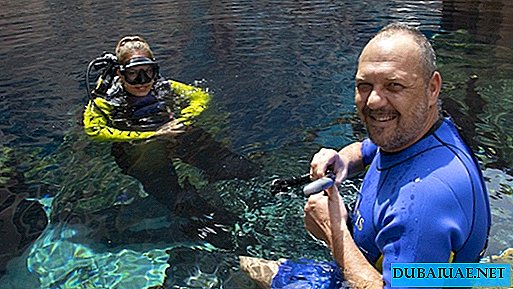 Text: Natalia Remmer
Text: Natalia Remmer The northern capital of Russia and one of the most beautiful corners of the world St. Petersburg celebrated the 310th anniversary of its founding. The city above the free Neva lives its own life, retaining the glory of a window to Europe in the radiance of white nights. A group of emirate enthusiasts have visited northern Venice and are in a hurry to share the latest city news with readers of Russian Emirates.
From coast to coast of the Neva
As you know, now, in order to move from one bank of the Neva to the other, you do not need to wait for dawn. The Bolshoi Obukhov bridge, also called the "cable-stayed" bridge, almost 3 km long, connected the two banks of the river, became the first non-movable crossing and part of the ring road encircling the city.
In addition, now from the new metro station "Admiralteyskaya" to the station "Sportivnaya" there is a night metro train, which also facilitates movement throughout the whole white night. The construction of the Western High-Speed Diameter, the first toll road in Russia, which will help relieve the city center and redirect traffic bypass from port to port bypassing it, continues in the city.
Another important section of the ring road is the Complex of protective structures against floods, in common people called “dams”.
I would like to believe that the famous unfinished building, which was finally put into operation a couple of years ago, will forever save Petersburg from the surge wave from the Gulf of Finland, which invariably caused flooding of the central part of the city in the autumn and winter
 Mariinka-2: the birth of a supernova
Mariinka-2: the birth of a supernova
The second stage of the famous Mariinsky Theater, opened May 2 this year, was a great addition to the cultural complex, which previously included the buildings of the historical imperial theater built in 1860, and the Concert Hall, commissioned in 2006. The new theater cannot be called a grandiose construction: 10 floors, of which three are underground, are connected by a 33-meter twisted staircase. The total area of the building is 80 thousand square meters. meters, of which 18,000 m 3 - the volume of the auditorium, accommodating 2 thousand people. The facade is framed by beige Jurassic marble, onyx dominates in the interior decoration, and unique Swarovski chandeliers decorate the lobby. Chamber concerts and art exhibitions will be held in the lobby, and performances by the stars of the white nights in the rooftop amphitheater.
On the opening day, all invited guests were able to appreciate the versatility of the scene, the convenience of the hall and the breadth of speaker capabilities. Performances of world-famous artists took place here: Ulyana Lopatkina, Diana Vishneva, Rene Pape, Anna Netrebko, Placido Domingo, Denis Matsuev, Olga Borodina.
House with lions
Are there any luxury standards by which Petersburg can compete with Dubai? Now it is. The fashionable Four Seasons Hotel opens in the northern capital this summer (this hotel brand has not yet been introduced in Dubai). The hotel is located in the historic Lion House, or the Lobanov Rostovsky mansion, next to St. Isaac's Cathedral, Admiralty and the State Hermitage Museum.
As you know, the famous mansion was built in the first third of the XIX century by Auguste Montferrand, the author of the already mentioned Isaac and the Pillar of Alexandria on Palace Square. It was on the back of one of the lions, whose sculptures adorn the front door, that Eugene, the main character of the poem "The Bronze Horseman" by A. Pushkin, escaped from the flood. The luxury hotel has 183 rooms with panoramic views, gourmet restaurants, conference rooms and a panoramic library bar. During the restoration of the building, lost decor elements were restored, so each guest will have the opportunity to immerse themselves in the atmosphere of Pushkin Petersburg.
Happy Birthday, beloved city! The rest is as well as possible said by the classics!
5 misconceptions about St. Petersburg1. St. Petersburg is named after Peter I
Many people mistakenly believe that St. Petersburg is named after its founder, Peter I. However, this is not so. The city bears the name of the heavenly patron of the first Russian emperor - the apostle Peter. The emperor wanted to name some fortress in honor of his heavenly patron long before the founding of St. Petersburg. Such a fortress should have been erected on the Don if the Azov campaign was successful, but it ended in failure. The fortress in honor of St. Peter was founded on May 16, 1703 on the Neva and was called St. Petersburg. But already on June 29, after laying the Peter and Paul Cathedral in the fortress, it became known as the Peter and Paul Cathedral, and the old original name Petersburg later spread to the whole city.
 2. The myth of the foundation of St. Petersburg
2. The myth of the foundation of St. Petersburg
“On May 16, 1703, during an inspection of the Enisaari Island, Peter, suddenly stopping, cut out two layers of turf, laid them crosswise and said:“ Here to be the city. ”At that time an eagle appeared in the air and began to soar above the king.” In fact, on Zayachy Island (in Enisaari in Finnish) it was not a city that was founded, but a fortress. The city arose later under its protection on the neighboring Birch Island.
Some researchers claim that Peter was not present during the laying (as historians have established, from May 11 to 20 he was not at all in the place of the future city).
3. The brass rider is made of copper
The Bronze Horseman is a symbol of the city. "The Bronze Horseman - we are all in the vibration of his copper," wrote A. A. Blok. However, the material of the monument is not copper, but bronze, and it got its name only after the appearance of the poem of the same name by A. S. Pushkin.
4. St. Petersburg was founded on an uninhabited desert territory
This legend is rooted in the minds of St. Petersburg, which contributed a lot to the lines from Pushkin's "Bronze Horseman": "On the shore of desert waves." We imagine an uninhabited desert area covered with forest and swamps. In fact, only on the site of the historical center of the city there were about 40 settlements, many of which even before the Swedish occupation belonged to Novgorod. The buildings of the future capital arose already on habitable places.
On the Vasilievsky Island there was a hunting lodge Delagardi, on the site of the Admiralty - a Swedish settlement, whose name could not be established; at the mouth of the Fontanka is the Kallila village (this is where Kalinkina village and Kalinkin bridge come from); on the site of the Engineering Castle - Manor Kanau with a well-groomed extensive garden (in its place the Summer Garden arose); in the Smolny district - Spasskoye village. Before the emergence of the city, there were settlements whose names still exist - Sabirino, Odintsovo, Kukarevo, Maksimovo, Volkovo and Kupchino.
5. The myth of the origin of the name "Vasilievsky Island"
About the origin of the name "Vasilievsky Island" is also a legend-fallacy. It is believed that under Peter at the western tip of the island there was a fortification, commanded by the artillery captain Vasily Korchmin. Sending orders to him, Peter wrote: “To Vasily to the island” - hence, allegedly, the name. But the name of the island existed before the foundation of St. Petersburg. It was mentioned back in 1500 in the census salary book of the Vodskaya (Vodinsky) pyatiny of Veliky Novgorod. At the same time, the island also had another Finnish name - Losiny (Hirvasaari). It was here that Peter intended to create the center of the city.
FROM PETER TO MOSCOW
For residents of two capitals, the words from the song “eight hours without sleep - from St. Petersburg to Moscow” have long been irrelevant. Since 2009, the Sapsan high-speed train runs between cities, accelerating to 240 km / h. Travel time is 3 hours 45 minutes. Also quickly, residents of northern Palmyra get to Helsinki, the capital of Finland, where the ultra-fast Allegro race rushes. And those who return to Dubai are taken from the second Pulkovo terminal every evening by the familiar Emirates Airline.










